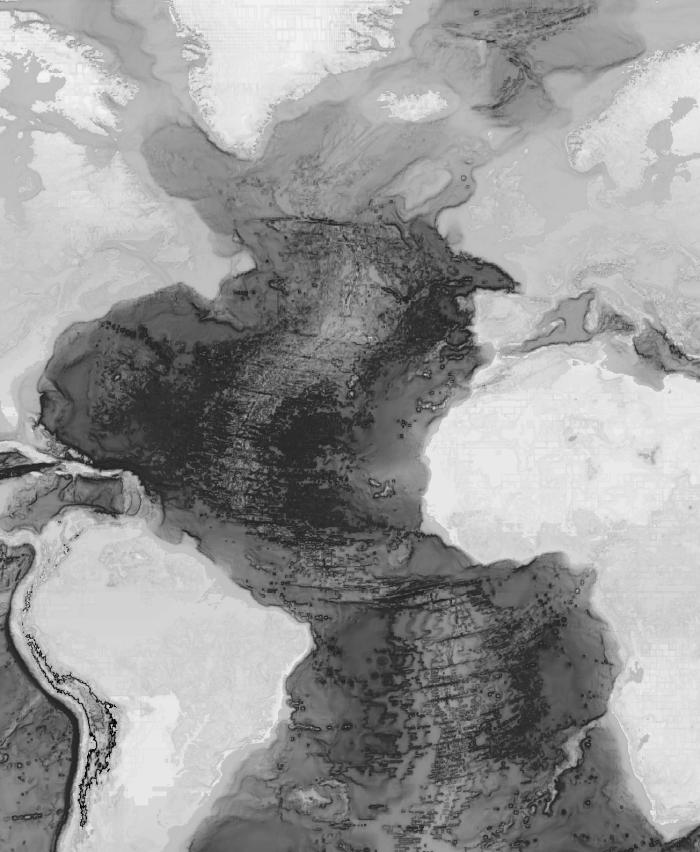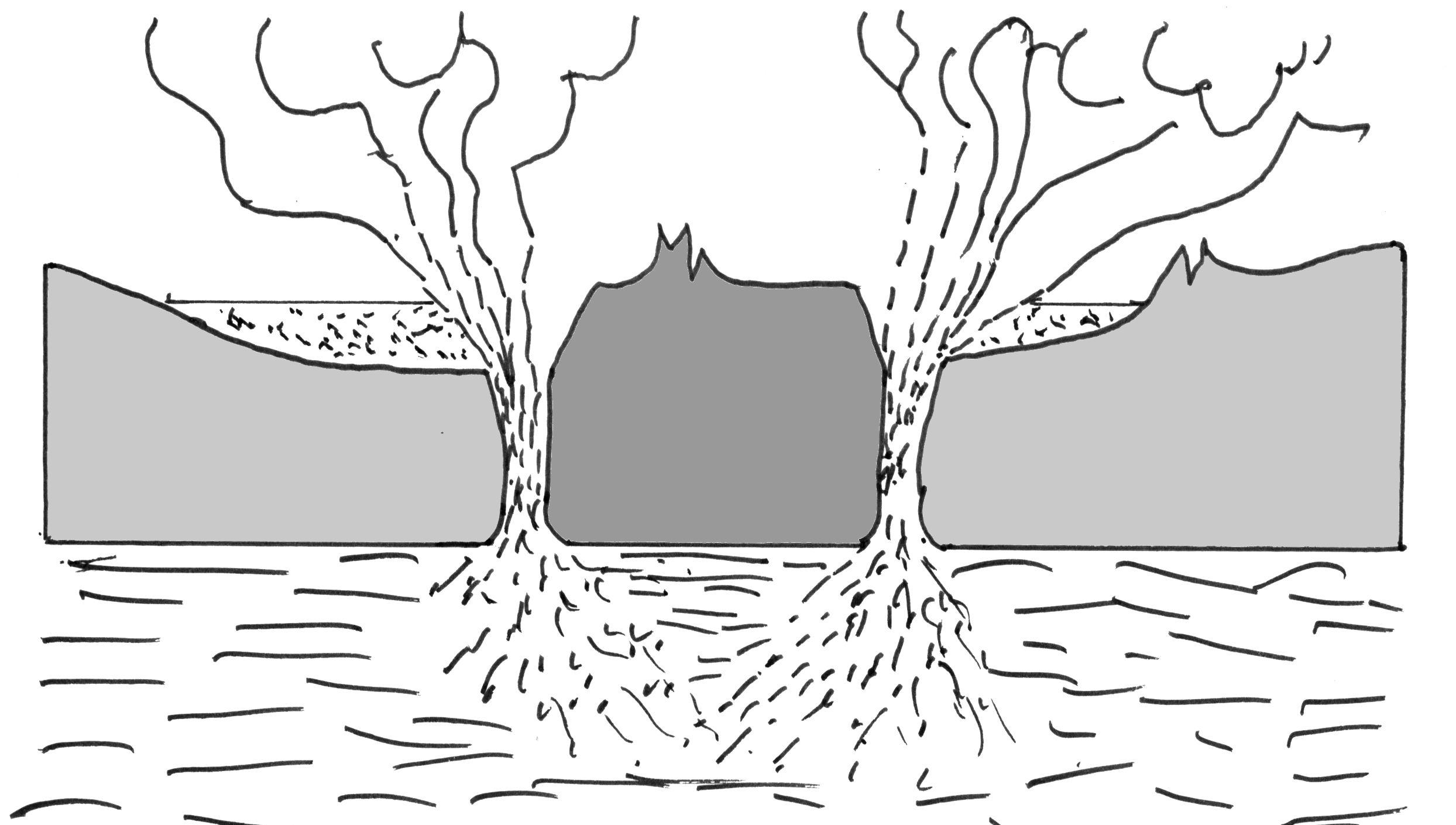Was This Atlantis?
Examination of the possible location and the reason of its disappearance.
Version Française.
The bottom of the Atlantic Ocean, has it been lowered?
 T
The bottom of the Atlantic Ocean, ie the ocean floor, gives us
the impression of being much lower than the rest of the oceans.
We can clearly see in the image, where the black is proportional to the
depth, that there is an area in the Atlantic Ocean who looks like to
be much lower than the rest. We can observe that there are two lines
between which the ocean floor has the look of having been lowered.
The first line goes from Ireland to Canada and the second line is
located between Africa, the side of the Ivory Coast, and French
Guinea to the other side.
We know that the bottom of the Atlantic Ocean is among the oceans
fund's the most volatile and it's not impossible that it could have
behaved like a cheese soufflé. At least this is suggested by
some scientists. Note that the currents of magma from the inner
Earth have a upward movement in this place and it's not impossible
that there is or was an accumulation of lava and gases in some places
as in a volcanic caldera. According to these scientists, these
accumulations have caused devastating volcanic eruptions, which
allegedly resulted in the collapse of the bubble and which would be
the explanation for the disappearance of Atlantis.
This
is the hypothesis putted forward by Mr Otto H Muck, who had suggested
that an asteroid would have caused such a collapse, as shown in the
illustration below.
|
Illustration
how an island can sink.
|
|
Before.
|
The
island is losing support and sinks.
|
After
|
|

|

|

|
We can also consider another possibility: one in which the
floor would have been depressed by the impact of a celestial body
that has either been an asteroid or a comet. Because a sufficient
great force, generated by the impact itself, could have pushed all
the magma to the opposite side of the Earth.
An island, can it sink without leaving any trace?
An island, can it sink into nothingness without leaving any trace, is
the question we should ask ourselves. It's certain that an island
might possibly sink, it's in fact enough that the so said island is
located between two tectonic plates, and the rock, which the island
is composed of, being heavier than the magma which is below it.
Then, it will be sufficient that the tectonic plates diverge
momentarily enough so that the island will lose its support to make
it sink. A small island could actually disappear in this way.
Magma, which comes up at the same time that the island sinks, will
cover it and forms a crust, below which the island would have
disappeared. This assumption is valid only if the island has had
time to sink before the magma solidifies. Thus, an island of larger
size, especially one measuring several hundred kilometers and more,
has no time sinking completely before the magma solidifies. Another
kind of disappearance which happens very often to volcanic islands is
the explosion of the volcano of which they are composed. The most
frequent cases of this type of loss is that the explosion of the
volcano they are composed of causes the
collapse of the volcano, and in some less frequent cases, that of the
island. An example of an island which has partly disappeared by such
an explosion is Thera.
The other assumption, that of an island caught between two
tectonic plates that would have sunk following a geological event, is
the part of the mid-Atlantic ridge formed by the islands of the
Azores. We can actually see that at the location of the Azores
islands, three tectonic plates join. These islands appear to be held
in a pincer movement by the American, Eurasian and African tectonic
plates.
The question of an island that could disappear without leaving a
trace, is thus not easy to answer. The smallest of them could
actually have done so. But this is quite different for the largest
of them and those that have exploded: they should have left at least
a trace of any kind. We should therefore have a trace of Atlantis
somewhere, taking into account that this island would have had at
least the size of North Africa and the Middle East of today together.
Where did all the matter go?
Where did all the matter go, seems to be a trivial question. But as we
have seen previously, an island can sink only on the condition that
the same amount of magma, which is below it, comes up in the same
time. Plato had spoken of an island of an estimated size of several
million square kilometers. The matter which should have come up this
case, would have amply covered the whole of Europe with a layer of
several hundred meters. Mr Otto H Muck had advanced the idea that
magma rising up in the form of volcanic ash, would have fallen down
back with the rains. According to him, Otto Muck H thus, the layers
of Loess that we find from the French Atlantic coast to the Pacific
coast of China would likely come from the disaster. It's certain
that at least part of the magma had been moved in this way there.
But the fact that the entire floor of the Atlantic Ocean appears to
have been lowered, suggest us that most of the magma hasn't been
moved up since the amount of Loess is not sufficient to explain the
lowering of the Atlantic Ocean floor. Then the volcanic debris found
so far aren't in sufficient quantities on the bottom of the Atlantic
Ocean. We can therefore assume that a large amount of magma has been
moved down, or even aside by an important mechanical force coming
from the outside.
Before looking further, we should realize that the amount of magma
that would have been displaced by a disaster, still largely exceeds
ten million-cubic kilometers. To understand the importance of the
phenomenon, just imagine that this amount would be sufficient to
cover the Eurasian tectonic plate with a layer of several hundred
meters. Although the Loess is there in an important quantity, it
could never explain the lowering of the North Atlantic Ocean floor.
There are certainly traces of volcanic material on the floor of the
ocean, but again we don't find them in sufficient quantities. Among
these there are traces we find some kinds of balls that could only
have been formed in the open air, which would have meant that the
magma had not solidify thousands of meters below sea water, but in
the open air before being on the ocean floor.
Conclusion:
Even without excluding any hypothesis, we can take the one which is most
obvious. It's likely that there would actually have been an
accumulation of lava and gas below the ocean floor, but not so much
that this could explain the descent of the ocean floor of thousands
of meters. The ocean floor has certainly been lowered by a brutal
force. Then when the impact occurred, the faults that had opened and
a significant amount of lava, gases and ash escaped. But the
volcanic ashes, which ended up falling, are not enough to explain
alone the collapse of the ocean floor. We thus have a combination of
these two cases: pushed down by a brutal impact of a celestial body,
followed by the escape of ash, gas and volcanic lava.
|





